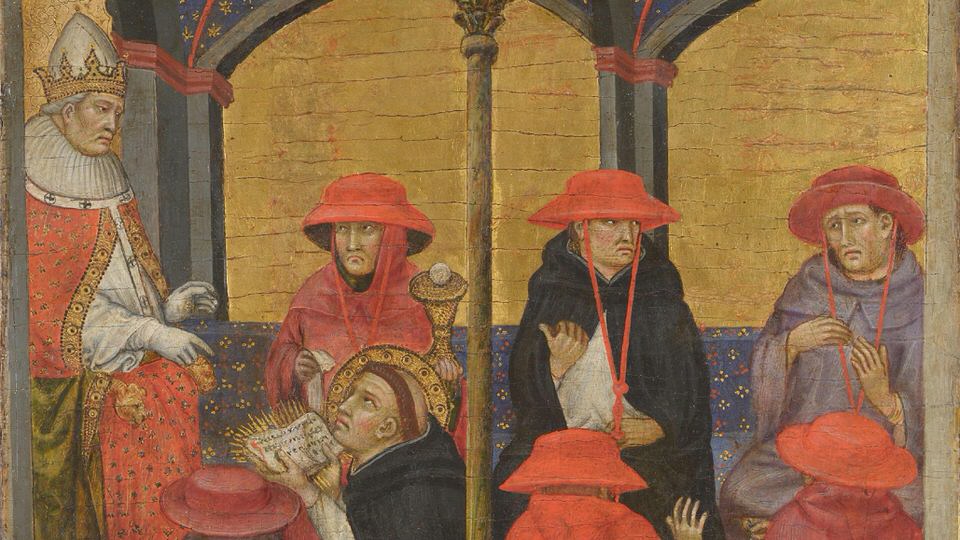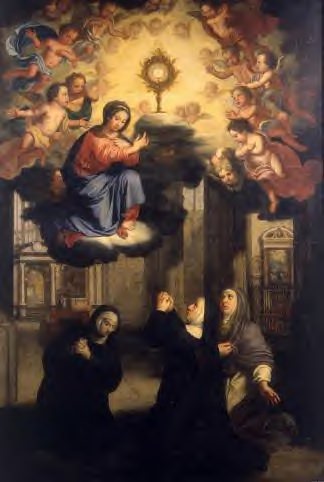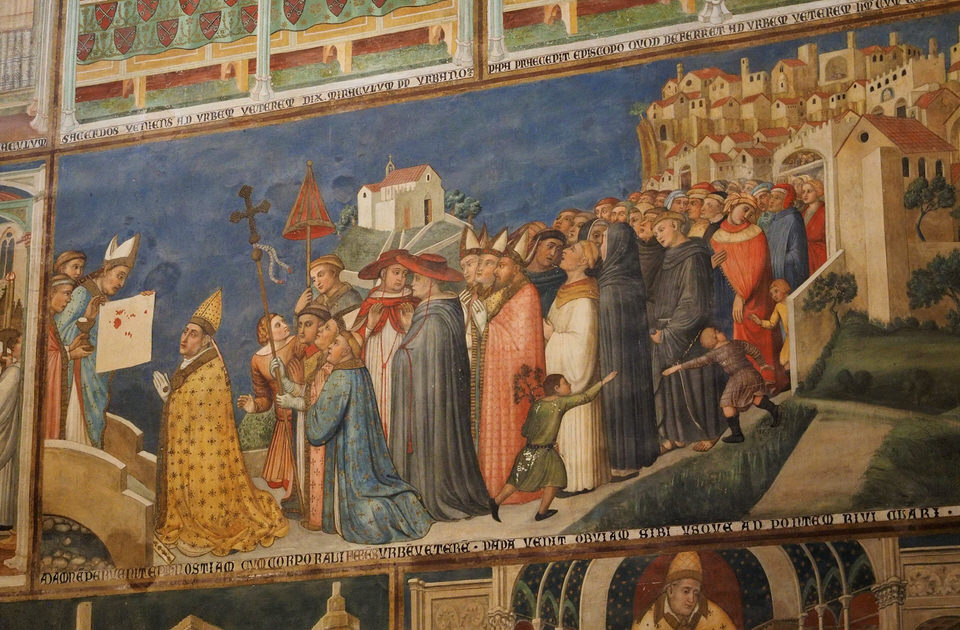

The true story of the feast of Corpus Christi
Kristina Glicksman
Friday, June 17, 2022

Saint Thomas Aquinas Submitting His Office of Corpus Domini to Pope Urban IV by Taddeo di Bartolo. Image courtesy of the Philadelphia Museum of Art.
There’s a great story about how the feast of Corpus Christi came about. You’ve probably heard it before. It involves a doubting priest, a pope, and one of the most celebrated saints of the medieval Church.
One day in the 13th century, a priest was on his way to Rome on a pilgrimage. He stopped in the town of Bolsena where he said Mass. He happened to be plagued by doubts about the Real Presence, and lo and behold, as he elevated the host, it began to bleed.
The priest immediately put a halt to Mass and rushed off to nearby Orvieto to tell Pope Urban IV (who happened to be staying there at the time). Having seen the evidence, the pope declared the event to be a miracle and decided to create a new feast day for the universal Church which would both celebrate the Eucharist and show all those doubters that they were wrong.
He asked the famous Dominican theologian Thomas Aquinas to compose the texts for the Mass and Office for the new feast, and one year later, in 1264, the Church first celebrated the feast of Corpus Christi and has done ever since.
It’s a beautiful story.
The only problem is, it isn’t true. Or not entirely.
Fake news?
It’s true that at some unspecified time, a Eucharistic miracle is believed to have occurred in Bolsena and that the bloody corporal is still venerated in Orvieto Cathedral.
It’s also true that Pope Urban IV instituted the feast of Corpus Christi for the universal Church in 1264, and it is generally accepted that Thomas Aquinas wrote the texts (widely considered to be some of the most beautiful ever written).
But the two stories aren’t connected.
The real history is more prosaic and lacks the razzle-dazzle of the miracle-inspired version, but where the false version puts doubt (and divine intervention) at the centre of the story, the real impetus behind this great feast day was a deep love for and veneration of the Eucharist.
And two women made it happen.
Introducing Juliana
The story of how Corpus Christi came to be begins not in Italy but in northern Europe: in Liège to be exact (then part of the Holy Roman Empire but now in Belgium). And it was not inspired by priests or popes or theologians but by the fervent devotion of ordinary people, and by the dream of one laywoman in particular: Juliana of Cornillon (also called Juliana of Liège).
Like many people in Liège at that time, Juliana had a strong devotion to Jesus Christ in the Eucharist, a devotion that was very much in tune with general trends in medieval European piety towards an increasing focus on Jesus’ earthliness and humanity, especially his suffering and death.
What set Juliana apart was an idea she had to create a special feast. At a young age, Juliana began to experience a vision of a full moon with a dark spot, which she interpreted (with the aid of a heavenly voice) as representing the Church with something missing – a yearly feast in honour of the Eucharist. For 20 years she kept this to herself, pondering it and probably working through the theological implications (besides being very devout and an ascetic, Juliana was also a bookworm!).
Juliana and Eve
 Extremely shy, Juliana finally shared her idea with a few trusted friends, including an anchoress named Eve. Not only was Eve much more outspoken than her shy friend, but anchoresses possessed a certain cachet in medieval Europe. People listened to them.
Long story somewhat short, though not everyone was thrilled with the idea (can you make the daily presence of God on earth more special with an extra feast day?), Eve and another friend, John of Lausanne, eagerly promoted the cause and found a sympathetic ear in the new bishop, Robert of Thourotte.
Juliana and a young monk put together all the texts and music, and in 1246, Bishop Robert established the feast of Corpus Christi in the diocese of Liège (because bishops could do that kind of thing back then). The only problem was, he died soon after.
Nevertheless, the first celebration of Corpus Christi took place on June 6, 1247, at the church of Saint-Martin, where Eve had her anchorage.
After Bishop Robert’s death, things in Liège took a turn for the worse, with politics having a deep impact on religious life, as it often did in those times – and these times were particularly turbulent. Juliana was run out of her convent, never to return. She died in 1258.
Extremely shy, Juliana finally shared her idea with a few trusted friends, including an anchoress named Eve. Not only was Eve much more outspoken than her shy friend, but anchoresses possessed a certain cachet in medieval Europe. People listened to them.
Long story somewhat short, though not everyone was thrilled with the idea (can you make the daily presence of God on earth more special with an extra feast day?), Eve and another friend, John of Lausanne, eagerly promoted the cause and found a sympathetic ear in the new bishop, Robert of Thourotte.
Juliana and a young monk put together all the texts and music, and in 1246, Bishop Robert established the feast of Corpus Christi in the diocese of Liège (because bishops could do that kind of thing back then). The only problem was, he died soon after.
Nevertheless, the first celebration of Corpus Christi took place on June 6, 1247, at the church of Saint-Martin, where Eve had her anchorage.
After Bishop Robert’s death, things in Liège took a turn for the worse, with politics having a deep impact on religious life, as it often did in those times – and these times were particularly turbulent. Juliana was run out of her convent, never to return. She died in 1258.

 Extremely shy, Juliana finally shared her idea with a few trusted friends, including an anchoress named Eve. Not only was Eve much more outspoken than her shy friend, but anchoresses possessed a certain cachet in medieval Europe. People listened to them.
Long story somewhat short, though not everyone was thrilled with the idea (can you make the daily presence of God on earth more special with an extra feast day?), Eve and another friend, John of Lausanne, eagerly promoted the cause and found a sympathetic ear in the new bishop, Robert of Thourotte.
Juliana and a young monk put together all the texts and music, and in 1246, Bishop Robert established the feast of Corpus Christi in the diocese of Liège (because bishops could do that kind of thing back then). The only problem was, he died soon after.
Nevertheless, the first celebration of Corpus Christi took place on June 6, 1247, at the church of Saint-Martin, where Eve had her anchorage.
After Bishop Robert’s death, things in Liège took a turn for the worse, with politics having a deep impact on religious life, as it often did in those times – and these times were particularly turbulent. Juliana was run out of her convent, never to return. She died in 1258.
Extremely shy, Juliana finally shared her idea with a few trusted friends, including an anchoress named Eve. Not only was Eve much more outspoken than her shy friend, but anchoresses possessed a certain cachet in medieval Europe. People listened to them.
Long story somewhat short, though not everyone was thrilled with the idea (can you make the daily presence of God on earth more special with an extra feast day?), Eve and another friend, John of Lausanne, eagerly promoted the cause and found a sympathetic ear in the new bishop, Robert of Thourotte.
Juliana and a young monk put together all the texts and music, and in 1246, Bishop Robert established the feast of Corpus Christi in the diocese of Liège (because bishops could do that kind of thing back then). The only problem was, he died soon after.
Nevertheless, the first celebration of Corpus Christi took place on June 6, 1247, at the church of Saint-Martin, where Eve had her anchorage.
After Bishop Robert’s death, things in Liège took a turn for the worse, with politics having a deep impact on religious life, as it often did in those times – and these times were particularly turbulent. Juliana was run out of her convent, never to return. She died in 1258.
*Image: Sainte Julienne du Mont-Cornillon (Juliana of Liège) and the Institution of the Feast of the Holy Sacrament by Englebert Fisen. This painting in the Church of St-Martin in Liège depicts St. Juliana of Cornillon, Blessed Eve of Saint-Martin, and Isabelle of Huy. (Source: Wikimedia Commons)
Corpus Christi goes global
However, a few years after Juliana’s death, one of the Liège theologians who had been supportive of the Corpus Christi feast, Jacques Pantaléon, was elected Pope Urban IV. On August 11, 1264, he promulgated the bull Transiturus de Hoc Mundo, which declared Corpus Christi a new feast for the entire Church. But alas, he, too, died not long after, and the celebration of the feast occurred only in certain locations until it was confirmed at the Council of Vienne in 1311-12.
We don’t know how much Eve and Jacques Pantaléon/Urban IV had kept in touch after he left Liège or whether she had urged him to establish the feast for the universal Church, but a month after the bull was published, he sent Eve a letter informing her of the new feast and giving her a copy of the liturgy composed by Thomas Aquinas.
Eve died in 1266.
But wait, there's more
What’s missing in this bare retelling (and which I’m really not qualified to give) is any real sense of the world in which Juliana, Eve, and Jacques Pantaléon lived – the spiritual and cultural context in which the feast of Corpus Christi was born. It was a world in which women were not accorded the rights and opportunities we have today but in which holy women, by virtue of their holiness, could command the respect and attention of theologians and prelates. A complex world with different ways of understanding ourselves and our relationships with God and with one another. A world that was not only different from our own but different, too, from the flat, stereotypical view many of us have of medieval society and the medieval Church.
I discovered, for example, in the course of my research, that there was a movement at the time towards lay people living together in religious communities without taking religious vows. This was especially popular among women, who could thereby maintain a certain level of independence from male authority.
I discovered this because I was trying to resolve a discrepancy I’d come across: some descriptions of Juliana call her an Augustinian nun, others a Norbertine. It turns out she spent most of her life as one of these religious laywomen (known as Beguines). She briefly succeeded in turning her community into an Augustinian convent before she was driven out and ended her life in a Cistercian abbey. It seems she was never a Norbertine, though the monastery at Cornillon had originally been founded as a Norbertine priory, so I guess that’s where the confusion comes from.
A celebration of the people, by the people, and for the people
But does it really matter?
Does it matter whether it was Juliana of Cornillon or Thomas Aquinas or “Peter of Prague” who inspired Urban IV to create the feast day? Does it matter whether Juliana was an Augustinian nun or a Norbertine or a laywoman? Surely what matters is that we have the feast.
I think it does matter. Everything in the history of the Church happens in a concrete time and place among real people who inhabit a specific cultural, social, and spiritual milieu. And as much as our liturgical and devotional practices evolve over time, they are still grounded in the circumstances which gave birth to them.
A Eucharistic celebration instituted from above on the basis of a miraculous event has a completely different meaning from one that came about through the growing devotion of the whole Church toward the person of Jesus Christ and the gift he left us in the sacrament of the altar.
Corpus Christi is one of those feasts (along with, for example, the Sacred Heart of Jesus and the Assumption) that remind us of the power of the laity to move the Church. In fact, I would say it is not only in our power, it is our duty as baptized Christians. But notice, please, the lesson St. Juliana teaches us: that we should use this power not for our own earthly ends but to give greater glory to God and to Jesus Christ, His Son.
Back to Bolsena
And what about the Eucharistic miracle at Bolsena? Even if all the evidence points toward it having nothing to do with the actual feast of Corpus Christi, it’s still a great story, so can’t we keep it?
Many people try. They conflate the two stories, giving credit to Juliana for the original idea, but insisting that it was the miracle which finally spurred the pope toward making the feast a reality.
Setting aside for a moment the fact that this version of events simply is not true, I think we should first ask ourselves why. Why do we continue to tell the story this way when the historical evidence does not bear it out?
It’s hard to know of course. I’m sure there are some who will say that it’s to take away from the impact of Juliana and Eve (who usually disappears from the story): two laywomen. It’s a cynical view, and it may be right, for all I know. After all, I don't think I could imagine us so persistently downplaying the contribution of a male saint or misrepresenting which order he belonged to.
It could merely be that we are simple creatures who love a good story. The Bolsena version sticks in our heads because its imagery appeals to our baser emotions like a good ghost story or a Gothic novel. A doubting priest and a bleeding host are more sensational, more memorable than a bookish woman (who wasn’t even a nun) and a vision of the moon. The action is simple, the outcome direct and uncomplicated (which should be the clearest sign that it is fable rather than fact). The real story is messy, more like the world we live in.
And perhaps that is the key.
Our lives are messy. We would love for them to be un-messy, but the thing is, the Son of God became man to sanctify that messiness, not to sanitize it. But he also left us with a promise that he has gone to prepare a place for us in heaven. And the visible sign of that promise is the Eucharist.
But in the meantime, we are called to live in the world – a world as messy and complicated as Juliana’s. And there’s no need to go looking for miracles. At every Mass we witness the greatest miracle of all: Jesus Christ transforming bread and wine into his very self for each one of us.
So what do we do with the Bolsena version of the story? It’s time to let it go.

Fresco by Ugolini di Prete Ilario depicting the arrival of the Corporal of Bolsena in Orvieto. Photo credit: Slices of Light, via Flickr.
Related Articles:
<<













